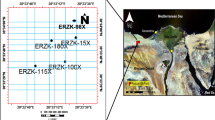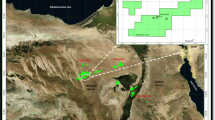Abstract
Introducing and applying an appropriate strategy for reservoir modeling in strongly heterogeneous and fractured reservoirs is a controversial issue in reservoir engineering. Various integration approaches have been introduced to combine different sources of information and model building techniques to handle heterogeneity in geological complex reservoir. However, most of these integration approaches in several studies fail on modeling strongly fractured limestone reservoir rocks of the Zagros belt in southwest Iran. In this study, we introduced a new strategy for appropriate modeling of a production formation fractured rock. Firstly, different rock types in the study area were identified based on well log data. Then, the Sarvak Formation was divided into nine zones, and the thinner subzones were used for further fine modeling procedure. These subzones were separated based on different fracture types and fracture distribution in each zone. This strategy provided sophisticated distribution of petrophysical parameters throughout the grids of the model, and therefore, it can handle strong heterogeneity of the complex reservoir. Afterward, petrophysical parameters were used to produce an up-scaled 3D gridded petrophysical model. Subsequently, maps of petrophysical properties were derived for each zone of the Sarvak Formation. Evidences achieved in this study indicates Sarvak Formation zone 2 as the target production zone with better performance of reservoir rock and the southwestern part of the field as area of maximum porosity.














Similar content being viewed by others
References
Abdideh, M., & Bargahi, D. (2012). Designing a 3D model for prediction the top of formation in oil fields using geostatistical methods. Geocartogrpahiy International Journal, 27, 569–579.
Aguilera, R. (2004). Integration of geology, petrophysics, and reservoir engineering for characterization of carbonate reservoirs through Pickett plots. AAPG Bulletin, 88(4), 433–446.
Beiranvand, B., & Kamali, M. R. (2004). Petrophysical evaluation and determination of rock types in a carbonate reservoir in SW Iran with interpretation of petrography and geophysical well logs. Iranian International Journal of Science, 5(2), 203–221.
Bordenave, M. L. (2002). The middle Cretaceous to early Miocene petroleum system in the Zagros domain of Iran, and its prospect evaluation. In: AAPG annual meeting, Houston, TX.
Bordenave, M. L., & Burwood, R. (1990). Source rock distribution and maturation in the belt, provenance of the Asmari and Sarvak reservoirs oil accumulations. Organic Geochemistry, 16, 369–387.
Bordenave, M. L., & Burwood, R. (1995). The albian Kazhdumi formation of the Dezful embayment, Iran: One of the most efficient petroleum generating systems. The petroleum source rocks series in Earth Sciences. Heidelberg: Springer.
Bordenave, M. L., & Huc, A. Y. (1993). The cretaceous source rocks in the Zagros foothills of Iran: An example of a large size intracratonic basin (pp. 727–753). Caracas, Venezuela: International Congress and Exhibition.
Burchette, T. P. (2012). Carbonate rocks and petroleum reservoirs: A geological perspective from the industry. Geological Society of London., 370, 17–37.
Caers, J. (2001). Geostatistical reservoir modeling using statistical pattern recognition. Journal of Petroleum Science and Engineering, 29(3–4), 177–188.
Cao, H. (2002). Development of techniques for general purpose simulators. PhD dissertation, Stanford University, Stanford, CA.
Daneh Dezfuli, A., & Bahrainian, S. S. (2014). A grid generation algorithm for reservoir domains with discrete fracture networks. International Journal of Oil, Gas and Coal Technology, 8(4), 417–431.
Dang, T. Q. C., Chen, Z., Nguyen, N. T. B., & Phung, T. H. (2015). An integrated geology and reservoir engineering approach for modeling of a giant fractured basement reservoir. International Journal of Oil, Gas and Coal Technology, 10(1), 39–59.
Demyanov, V., Backhous, L., & Christi, M. (2015). Geological feature selection in reservoir modeling and history matching with Multiple Kernel Learning. Computers & Geosciences, 85, 16–25.
Fanchi, J. R. (2006). Principles of applied reservoir simulation. Burlington: Gulf Publishing, Elsevier.
Gong, B., Karimi-Fard, M., & Durlofsky, L. J. (2006). An upscaling procedure for constructing generalized dual-porosity/dual permeability model from discrete fracture characterizations. In Proceeding of annual technical conference and exhibition, Texas.
Haining, R. (2003). Spatial data analysis: Theory and practice. Cambridge, UK: Cambridge University Press.
Holden, L., Mostad, P., Nielsen, B. F., Gjered, J., Townsend, C., & Ottesen, S. (2003). Stochastic structural modeling. Journal of Mathematical Geology, 35(8), 899–914.
Jafari, A., & Babadagli, T. (2012). Estimation of equivalent fracture network permeability using fractal and statistical network properties. Journal of Petroleum Science and Engineering, 92, 110–123.
Jones, R. R., McCaffrey, K. J. W., Clegg, P., Wilson, R. W., Holliman, N. S., Holdworth, R. E., et al. (2009). Integration of regional to outcrop digital data: 3D visualization of multi-scale geological models. Computers & Geosciences, 35(1), 4–18.
Kalantari-Dahaghi, A., & Mohaghegh, S. D. (2011). A new practical approach in modeling and simulation of shale gas reservoirs: Application to New Albany Shale. International Journal of Oil, Gas and Coal Technology, 4(2), 104–133.
Kamali, M. R., Omidvar, A., & Kazemzadeh, E. (2013). 3D geostatistical modeling and uncertainty analysis in a carbonate reservoir, SW Iran. Journal of Geological Research. doi:10.1155/2013/687947.
Karimi-Fard, M., Durlofsky, L. J., & Aziz, K. (2004). An efficient discrete fracture model applicable for general-purpose reservoir simulators. Society of Petroleum Engineers Journal, 9(2), 227–236.
Karimi-Fard, M., Gong, B., & Durlofsky, L. J. (2006). Generation of coarse-scale continuum flow models from detailed fracture characterizations. Water Resource Research, 42(10), 1–13.
Kaufmann, O., & Martin, T. (2008). 3D geological modeling from boreholes, cross section and geological maps, application over former natural gas storages in coal mines. Computers & Geosciences, 34, 278–290.
Koike, K., Kubo, T., Liu, C., Masoud, A., Amano, K., Kurihara, A., et al. (2015). 3D geostatistical modeling of fracture system in a granitic massif to characterize hydraulic properties and fracture distribution. Tectnophysiscs, 660, 1–16.
Lelliott, M. R., Cave, M. R., & Walthall, G. P. (2009). A structured approach to the measurement of uncertainty in 3D geological model. Journal of Engineering Geology and Hydrogeology, 42(1), 95–105.
Ma, Y. Z., & La Pointe, P. R. (2011). Uncertainty analysis and reservoir modeling. Tulsa: AAPG Publishing.
Manzocchi, M., & Walsh, J. (2002). The SAIGUP project—Sensitivity analysis of the impact of geological uncertainties on production forecasting in clastic hydrocarbon reservoirs. In 64th EAGE conference and exhibition Florence, Italy.
Maschio, C., Vidal, A. C., & Schiozer, D. J. (2008). A framework to integrate history matching and geostatistical modeling using genetic algorithm and direct search methods. Journal of Petroleum Science and Engineering, 63(1), 34–42.
Mohaghegh, S. D., Gruic, O., Zargari, S., Kalantari-Dahaghi, A., & Bromhal, G. S. (2012). Top-down, intelligent reservoir modeling of oil and gas producing shale reservoirs: Case studies. International Journal of Oil, Gas and Coal Technology, 5(1), 3–28.
Mohaghegh, S. D., Modavi, C. A., Hafez, H. H., Haajizadeh, M., Kenawy, M. M., & Guruswamy, S. (2009). Development of surrogate reservoir model (SRM) for fast track analysis of a complex reservoir. International Journal of Oil, Gas and Coal Technology, 2(1), 2–23.
Moradi, S., Moghani-Rahimi, A., Zargar, G., & Kakavandi, M. (2015). Investigation of cementation exponent (m) in heterogeneous carbonate reservoirs via integration of thin section analysis and well logging. International Journal of Oil, Gas and Coal Technology, 9(4), 379–393.
Nazari Ostad, M., Asgharia, O., Emery, X., Azizzadeh, M., & Khoshbakht, F. (2016). Fracture network modeling using petrophysical data, an approach based on geostatistical concepts. Journal of Natural Gas Science and Engineering, 31, 758–768.
Nikravesh, M. (2007). Computational intelligence for geosciences and oil exploration. Forging New Frontiers, Fuzzy Pioneers, 66, 267–332.
Olowokere, M. T. (2010). Geostatistical modeling of interval velocity to quantifying hydrocarbon resource in multi-layer reservoir from TMB field, Niger delta. International Journal of Physical Sciences, 5(12), 1897–1907.
Palermo, D., Aigner, T., Seyfang, B., & Nardon, S. (2012). Reservoir properties and petrophysical modeling of carbonate sand bodies: Outcrop analogue study in an epicontinental basin. London, Special Publications: Geological Society.
Prévost, M., Lepage, F., Durlofsky, L. J., & Mallet, J. L. (2005). Unstructured 3D gridding and upscaling for coarse modeling of geometrically complex reservoirs. Petroleum Geoscience, 11(4), 339–345.
Pulido, H., Samaniego, F., Galicia-Muñoz, G., Rivera, J., & Vélez, C. (2007). Petrophysical characterization of carbonate naturally fractured reservoirs for use in dual porosity simulators proceedings. In 32nd conference on geothermal reservoir engineering. SGP-TR-183. Stanford, CA: Stanford University.
Rühaak, W., Bär, K., & Sass, I. (2014). Combining numerical modeling with geostatistical interpolation for an improved reservoir exploration. Energy Procedia, 59, 315–322.
Sacchi, Q., Borello, E. S., Weltje, G. J., & Dalman, R. (2016). Increasing the predictive power of geostatistical reservoir models by integration of geological constraints from stratigraphic forward modeling. Marine and Petroleum Geology, 69, 112–126.
Samadi, H. R., & Salehi, M. H. (2013). Static 3D modeling of hydrocarbon reservoir with the help of RMS case of studies: The South East anticline of Khuzestan Iran. Journal of Basic and Applied Science Research, 3(2), 473–477.
Samimi, A. K., & Karimi, G. (2014). Sensitivity and uncertainty analysis of original oil in place in carbonate reservoir modeling, a case study. Petroleum and Coal, 56(3), 332–338.
Soleimani, M. (2016). Seismic imaging by 3D partial CDS method in complex media. Journal of Petroleum Science and Engineering, 143, 54–64.
Soleimani, M., & Zarvani, A. S. (2009). Lithological and petrophysical evaluation of the caprock keybeds, Asmari Reservoir of Pazanan Oil Field, Zagros, Iran. Songklanakarin Journal of Science and Technology, 31(6), 655–660.
Soliemani, M., & Jodeiri Shokri, B. (2015). 3D static reservoir modeling by geostatistical techniques used for reservoir characterization and data integration. Environmental Earth Science, 74, 1403–1414.
Wu, H., & Pollard, D. D. (2002). Imaging 3-D fracture networks around boreholes. American Association of Petroleum Geologist Bulletin, 86, 593–604.
Acknowledgments
The authors would like to thank four anonymous reviewers for their constructive comments in improving the manuscript.
Author information
Authors and Affiliations
Corresponding author
Rights and permissions
About this article
Cite this article
Soleimani, M., Jodeiri Shokri, B. & Rafiei, M. Integrated Petrophysical Modeling for a Strongly Heterogeneous and Fractured Reservoir, Sarvak Formation, SW Iran. Nat Resour Res 26, 75–88 (2017). https://doi.org/10.1007/s11053-016-9300-9
Received:
Accepted:
Published:
Issue Date:
DOI: https://doi.org/10.1007/s11053-016-9300-9




